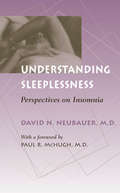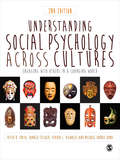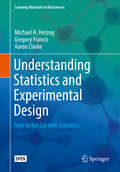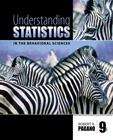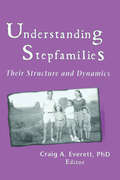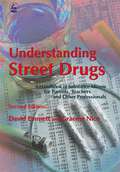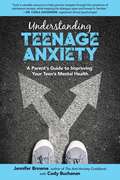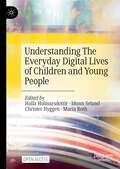- Table View
- List View
Understanding Sleep and Dreaming
by William H. MoorcroftAn updated edition of Moorcroft's 2003 volume, this new work reflects recent scientific advances in the area of sleep and disorders. As in the previous book, Understanding Sleep and Dreaming, this new edition serves as a compact overview for now sleep experts, covering physiological sleep mechanisms, brain function, psychological ramifications of sleep, dimensions of dreaming, and clinical disorders associated with sleep. It is accessibly written with specially boxed material that enhances the text. It also offers a good foundation for those who will continue sleep studies, while at the same time offering enough information for those who will apply this knowledge in other ways such as clinicians private practices or researchers. It is an excellent text for courses on sleep at the undergraduate and graduate levels. The section on sleep labs will show how computers have replaced former models of data collection and storage; includes the new area of the genetics of sleep; add a new box on teen sleep; insert a new box on the emerging information about how technology use affects sleep; emphasize the controversy over rampart, wide-spread sleep deprivation; and include a new box covering the connection between sleep loss and weight gain. Additional inclusions might incorporate current "hot topics," such as the effect of shift work on sleep, sleep problems in adolescents, and nightmare treatment for people suffering from PTSD.
Understanding Sleeplessness: Perspectives on Insomnia
by David N. NeubauerSeemingly the most natural and necessary of pursuits, a good night's sleep eludes a remarkable number of people—up to 50 percent of the general population, according to studies, while 10 to 15 percent suffer from severe or chronic sleep disorders. Because the causes and nature of sleeplessness are so many and varied—and often as elusive as sleep itself—the diagnosis and treatment require a flexible, multifaceted approach—and this is precisely what David N. Neubauer lays out in Understanding Sleeplessness.Building on the "four perspectives" conceptualized by McHugh and Slavney in The Perspectives of Psychiatry, Neubauer offers a much-needed explanation of the diverse ways of understanding what insomnia is and what should be done about it. He begins by surveying what is currently known about the mechanisms of "normal sleep" and, in this light, describing the problems of defining, assessing, and measuring insomnia. Drawing examples from patients studied at the Johns Hopkins Sleep Disorders Center, Neubauer then applies each of the four perspectives—diseases, dimensions, behaviors, life stories—to the varied kinds and degrees of sleeplessness. Finally, calling on the full range of perspectives on insomnia, he outlines an integrated approach to evaluation and treatment. His work will be of great interest and value to those who study and treat sleeplessness and to those who wish to understand this widespread and vexing problem.
Understanding Social Psychology Across Cultures: Engaging with Others in a Changing World (Sage Social Psychology Program Ser.)
by Vivian L. Vignoles Ronald Fischer Peter B. Smith Michael H. BondUnderstanding Social Psychology Across Cultures Second Edition starts by asking why social psychology needs a cross-cultural perspective. It then examines cultural differences and their origins, before addressing traditional social psychological themes cross-culturally, for example group processes, self and identity, intergroup relations. Themes of contemporary relevance including migration, ethnic conflict and climate change are also covered.<P><P> Key features:<P> * Presentation of concepts and theories made accessible to the reader using practical examples and everyday life experiences from diverse parts of the world<P> * Biographical portraits of key researchers in the field<P> * Coverage of the appropriate methods for conducting state-of-the-art cross-cultural research<P> This textbook is appropriate for students of social and cross-cultural psychology. It will also interest practitioners wanting to understand the impact of culture on their fields of work, such as international relations, social policy, health promotion, ethnic relations and international business.
Understanding Specific Learning Difficulties
by Margot PriorAn increase in research into all facets of learning difficulties has resulted in a deeper understanding of the problems. This book includes a description and explanation of reading, spelling and learning difficulties; provides chapters on psychological and neuropsychological assessment; explains the associations between behavioural problems and learning difficulties; and critically reviews remedial approaches, incorporating a summary of what is known about their efficacy. The importance of dealing with attendant behavioural problems and the significance of phonological knowledge in literacy learning are central themes.; Intended to be a succinct and accessible synthesis of current knowledge in this area, this book should be of interest to professionals who encounter children with learning difficulties, tertiary students and parents.
Understanding Sport Psychology
by Aidan Moran Cathy Craig Gavin Breslin John Kremer Stephen ShannonSports Psychology is a popular area that has grown dramatically over the past few decades due to an increasing emphasis on the importance of psychology for athletic performance, engagement in exercise and in the business and industry of sport. This text is a concise, focussed overview of all the core concepts in sports psychology at both undergraduate and postgraduate level. Using key studies and evidence, this book explains and develops key topics, and acts as a springboard for further reading and debate. This is a stimulating and practical resource for sport and exercise students, sport coaches, and athletes alike, covering new developments within the field including: Social Identity Theory, Mental Health Awareness in Sport, Resilience and Mindfulness. With additional pedagogy including further reading, figures and diagrams to help visualise key theories, and case studies, Understanding Sport Psychology is essential reading for any student of sport psychology.
Understanding Sport Psychology
by Aidan Moran Cathy Craig Gavin Breslin John Kremer Stephen ShannonSports Psychology is a popular area that has grown dramatically over the past few decades due to an increasing emphasis on the importance of psychology for athletic performance, engagement in exercise and in the business and industry of sport. This text is a concise, focussed overview of all the core concepts in sports psychology at both undergraduate and postgraduate level. Using key studies and evidence, this book explains and develops key topics, and acts as a springboard for further reading and debate. This is a stimulating and practical resource for sport and exercise students, sport coaches, and athletes alike, covering new developments within the field including: Social Identity Theory, Mental Health Awareness in Sport, Resilience and Mindfulness. With additional pedagogy including further reading, figures and diagrams to help visualise key theories, and case studies, Understanding Sport Psychology is essential reading for any student of sport psychology.
Understanding Statistical Concepts Using S-plus
by Randall E. Schumacker Allen AkersWritten as a supplemental text for an introductory or intermediate statistics course, this book is organized along the lines of many popular statistics texts. The chapters provide a good conceptual understanding of basic statistics and include exercises that use S-PLUS simulation programs. Each chapter lists a set of objectives and a summary. The book offers a rich insight into how probability has shaped statistical procedures in the behavioral sciences, as well as a brief history behind the creation of various statistics. Computational skills are kept to a minimum by including S-PLUS programs that run the exercises in the chapters. Students are not required to master the writing of S-PLUS programs, but explanations of how the programs work and program output are included in each chapter. S-PLUS is an advanced statistical package that has an extensive library of functions, which offer flexibility in writing customized routines. The S-PLUS functions provide the capability of programming object and dialog windows, which are commonly used in Windows software applications. The S-PLUS program also contains pull-down menus for the statistical analysis of data. A ZIP file containing programs that work in S-PLUS 6.2 for use with this book is available for download from http://www.psypress.com/resources/9780805836233.zip - please note that these scripts will only run in S-PLUS 6.2 and not later versions due to changes in the programming language syntax.
Understanding Statistics and Experimental Design: How to Not Lie with Statistics (Learning Materials in Biosciences)
by Gregory Francis Michael H. Herzog Aaron ClarkeThis open access textbook provides the background needed to correctly use, interpret and understand statistics and statistical data in diverse settings. Part I makes key concepts in statistics readily clear. Parts I and II give an overview of the most common tests (t-test, ANOVA, correlations) and work out their statistical principles. Part III provides insight into meta-statistics (statistics of statistics) and demonstrates why experiments often do not replicate. Finally, the textbook shows how complex statistics can be avoided by using clever experimental design. Both non-scientists and students in Biology, Biomedicine and Engineering will benefit from the book by learning the statistical basis of scientific claims and by discovering ways to evaluate the quality of scientific reports in academic journals and news outlets.
Understanding Statistics in the Behavioral Sciences
by Roger Bakeman Byron F. RobinsonUnderstanding Statistics in the Behavioral Sciences is designed to help readers understand research reports, analyze data, and familiarize themselves with the conceptual underpinnings of statistical analyses used in behavioral science literature. The authors review statistics in a way that is intended to reduce anxiety for students who feel intimidated by statistics. Conceptual underpinnings and practical applications are stressed, whereas algebraic derivations and complex formulas are reduced. New ideas are presented in the context of a few recurring examples, which allows readers to focus more on the new statistical concepts than on the details of different studies.The authors' selection and organization of topics is slightly different from the ordinary introductory textbook. It is motivated by the needs of a behavioral science student, or someone in clinical practice, rather than by formal, mathematical properties. The book begins with hypothesis testing and then considers how hypothesis testing is used in conjunction with statistical designs and tests to answer research questions. In addition, this book treats analysis of variance as another application of multiple regression. With this integrated, unified approach, students simultaneously learn about multiple regression and how to analyze data associated with basic analysis of variance and covariance designs. Students confront fewer topics but those they do encounter possess considerable more power, generality, and practical importance. This integrated approach helps to simplify topics that often cause confusion.Understanding Statistics in the Behavioral Sciences features:*Computer-based exercises, many of which rely on spreadsheets, help the reader perform statistical analyses and compare and verify the results using either SPSS or SAS. These exercises also provide an opportunity to explore definitional formulas by altering raw data or terms within a formula and immediately see the consequences thus providing a deeper understanding of the basic concepts.*Key terms and symbols are boxed when first introduced and repeated in a glossary to make them easier to find at review time.*Numerous tables and graphs, including spreadsheet printouts and figures, help students visualize the most critical concepts.This book is intended as a text for introductory behavioral science statistics. It will appeal to instructors who want a relatively brief text. The book's active approach to learning, works well both in the classroom and for individual self-study.
Understanding Statistics in the Behavioral Sciences (Tenth Edition)
by Robert R. Pagano<p>Based on over 30 years of successful teaching experience in this course, Robert Pagano's introductory text takes an intuitive, concepts-based approach to descriptive and inferential statistics. He uses the sign test to introduce inferential statistics, empirically derived sampling distributions, many visual aids, and lots of interesting examples to promote reader understanding. <p>One of the hallmarks of this text is the positive feedback from users--even those not mathematically inclined praise the text for its clarity, detailed presentation, and use of humor to help make concepts accessible and memorable. Thorough explanations precede the introduction of every formula, and the exercises that immediately follow include a step-by-step model that lets readers compare their work against fully solved examples. This combination makes the text perfect for anyone building their foundation of knowledge for analyzing statistics in psychology or other social and behavioral sciences.</p>
Understanding Statistics in the Behavioural Sciences (9th edition)
by Robert R. PaganoBased on over 30 years of successful teaching experience in this course, Robert Pagano's introductory text takes an intuitive, concepts-based approach to descriptive and inferential statistics. He uses the sign test to introduce inferential statistics, empirically derived sampling distributions, many visual aids and lots of interesting examples to promote student understanding. One of the hallmarks of this text is the positive feedback from students-even students who are not mathematically inclined praise the text for its clarity, detailed presentation, and use of humor to help make concepts accessible and memorable. Thorough explanations precede the introduction of every formula-and the exercises that immediately follow include a step-by-step model that lets students compare their work against fully solved examples. This combination makes the text perfect for students taking their first statistics course in psychology or other social and behavioral sciences.
Understanding Stepfamilies: Their Structure and Dynamics
by Craig EverettUnderstanding Stepfamilies takes a large step toward achieving integration of the many variables presented in understanding the stepfamily system. The book examines the dynamics and resources within these complex family systems. It helps clinicians and researchers understand the underlying structural patterns and dynamics of stepfamilies, promoting more successful, positive treatment outcomes. Chapters in Understanding Stepfamilies offer clinicians and researchers an international perspective, including contributions from the U.S., Canada, Israel, and The Netherlands. Readers learn of unique theoretical approaches to understanding stepfamily typologies and behaviors and specific clinical models for assessment and intervention, as well as more empirically-based findings regarding parent-child interactions.
Understanding Street Drugs: A Handbook of Substance Misuse for Parents, Teachers and Other Professionals Second Edition
by Graeme Nice David EmmettThis fully updated edition of the essential reference Understanding Drugs provides a complete overview of the key facts and core issues surrounding substance misuse. All commonly-used street drugs are covered, with quick reference guides, helpful diagrams and clear information on each drug's effects, methods of use, legal status, availability, treatment options and associated slang. This edition includes new sections on ketamine, `date-rape' drugs, and over-the-counter opiate-based drugs, and recent findings on the long-term effects of cannabis and its potential medicinal use, and discussion of the legalisation debate. This comprehensive handbook is an essential reference for teachers, social workers, youth workers, residential home managers, policy makers and parents, enabling readers to recognise drug misuse and confidently offer information and guidance. A companion volume, Understanding Drug Issues: A Photocopiable Resource Workbook is also available from Jessica Kingsley Publishers.
Understanding Students with Additional Needs as Learners
by Patrick Griffin Kerry WoodsThis book brings together a compendium of the collaborative research from eight PhD students and three researchers, addressing an existing problem for teachers of students with additional learning needs in mainstream classes. The purpose of this research is to describe the development of growth progressions in communication and literacy, interpersonal skills and understanding of emotions, learning skills, numeracy, movement, digital literacy, thinking and problem-solving skills among students with additional needs in the classroom, known as SWANS (Students with Additional Needs). The research has grown over a decade or more and this volume brings all that research together under a single cover in a way that has not been done before. It shows how work conducted at the same system and school level that led to the design of curriculum support for SWANS, drawing on the research to establish expected learning progressions, was linked to a mainstream curriculum. It also illustrates strategies and materials that could be used by mainstream teachers or special education teachers to make teaching SWANS practical and effective. The book offers new insights, and a ready to use volume of material for curriculum writers, student teachers, researchers, and special education teachers and administrators.
Understanding Suicide
by Ben Fincham Jonathan Scourfield Susanne Langer Michael ShinerSociologists have debated suicide since the early days of the discipline. This book assesses that body of work and breaks new ground through a qualitatively-driven, mixed method 'sociological autopsy' ofone hundredsuicides that explores what can be known about suicidal lives. "
Understanding Suicide
by Philippe CourtetIn this book international experts address a range of key current issues relating to suicide. The opening chapters discuss nosology, definitions, clinical determinants, and conceptual models of the suicide process and consider the evidence regarding potential biomarkers of suicide risk based on neuroscientific research. Adopting a neo-Durkheimian perspective, the role of various social factors in the genesis of suicidal behavior is then explored in depth. Practical user-friendly tools that facilitate risk assessment by clinicians are provided, and detailed consideration is given to efficient and innovative strategies for the prevention of suicide and the treatment of suicidal behavior, such as psychotherapy, psychopharmacological approaches, and effective organization of care, including surveillance and the use of online tools. The final part of the book focuses on the need for and development of a personalized approach within the field of suicide prevention.
Understanding Suicide Terrorism
by Radhika HalderUnderstanding Suicide Terrorism aims to explore the different aspects involved in suicide terrorism for a better understanding of the tactic which has become a global phenomenon and threat today. The book aims to help inform holistic policy making by tracing the evolution of the use of suicide as a weapon in conflict and the emergence of modern-day suicide terrorism. The book uses case studies of prominent terror outfits to have used the tactic rather confidently and consistently and suggests that suicide terrorism must be understood as the interplay of three vital components—the individual committing the act, the organization employing the tactic and, the state environment contributing to the culture of suicide terrorism. Subsequently, a purely weapons-based approach to counter terrorism cannot be relied upon to solve a threat such as suicide terrorism which is so deeply ingrained in ideology and symbolism. The book comes at a time when suicide terrorism has been one of the most potent and effective tools for individuals and entities to achieve what they perceive as goals and shall inevitably remain a challenge for policy makers and security establishments to deal with. Please note: Taylor & Francis does not sell or distribute the Hardback in India, Pakistan, Nepal, Bhutan, Bangladesh and Sri Lanka
Understanding Technology and Society: Seminal Questions and Enduring Insights
by Todd L. PittinskyFrom the early days of navigating the world with bare hands to harnessing tools that transformed stones and sticks, human ingenuity has birthed science and technology. As societies expanded, the complexity of our tools grew, raising a crucial question: do we control them, or do they dictate our fate? The trajectory of science and technology isn't predetermined; debates and choices shape it. It's our responsibility to navigate wisely, ensuring technology betters, not worsens, our world. This book explores the complex nature of this relationship, with 18 chapters posing and discussing a compelling 'big question.' Topics discussed include technology's influence on child development, big data, algorithms, democracy, happiness, the interplay of sex, gender, and science in its development, international development efforts, robot consciousness, and the future of human labour in an automated world. Think critically. Take a stand. With societal acceleration mirroring technological pace, the challenge is: can we keep up?
Understanding Teen Eating Disorders: Warning Signs, Treatment Options, and Stories of Courage
by Cris E. Haltom Cathie Simpson Mary TantilloUnderstanding Teen Eating Disorders introduces readers to common teen eating disorder scenarios, their warning signs, and treatment options. Each chapter examines a teen or tween and brings the factors, whether they be environmental, genetic, co-existing conditions, etc. that contribute to his or her eating disorder, to life, while seamlessly integrating the latest research in gene inheritance, brain chemistry, and eating disorders in accessible, reader-friendly language. Each chapter provides treatment options, including outpatient, group therapy, and in-patient programs, for both the young person and the family. Each also ends with a Q & A section that reflects the concerns a parent, loved one, or treatment professional may have.
Understanding Teenage Anxiety: A Parent's Guide to Improving Your Teen's Mental Health
by Jennifer Browne Cody BuchananIf you’re the parent of a teenager experiencing chronic anxiety, this book is for you.Today’s teens are high-strung and socially overextended. We shrug it off as a millennial problem, but is it? In a world that encourages the quick fix, instant gratification, and real-time feedback, can we really expect our children to cope as we did less than two decades ago, in the land of handshakes, eye contact, elbow grease, and grit?This book is a product of a combination of three very different perspectives: those of the anxious teen, the parent, and the therapist. We need to understand what we’ve created in terms of our current society to gain proper insight on why we’re seeing increasingly rising levels of anxiety in our teenagers. Topics include:Physical and Emotional Symptoms of AnxietyTeens and Self-HarmAnxiety and Gut HealthSports: Concussions and AnxietyNatural Ways to Help Your Teen CopeAnd much, much moreWithin each chapter, author (and parent) Jennifer Browne and co-author (Jennifer’s teenage son) Cody Buchanan, who struggles with anxiety and depression, will weigh in on what this affliction feels like, physically, mentally, and emotionally. They share personal experiences to help parents better understand their teens and learn a lot along the way.
Understanding Teenage Depression: A Guide to Diagnosis, Treatment, and Management
by Nicholas Bakalar Maureen EmpfieldBased on the latest scientific findings, a comprehensive guide to the diagnosis and treatment of teenage depression. Each year thousands of American teenagers are diagnosed with clinical depression. If ignored, poorly treated, or left untreated, it can be a devastating illness for adolescents and their families. Drawing on her many years of experience as a psychiatrist working with teenagers, Dr. Maureen Empfield answers the questions parents and teens have about depression, providing detailed information on: *Identifying the different types of depression *How depression is diagnosed *Which teenagers are most at risk *Suicide *The effect of depression on other teenage problems *How depression is treated and by whom *The drugs used to treat teenage depression - what they are and how they work *When a teenager needs to be hospitalized for depression *and more. Understanding Teenage Depression provides the latest scientific findings on this serious condition, and the most up-to-date information on its treatment.The book includes numerous vignettes drawn from Dr. Empfield's clinical practice as well as first person accounts from teenagers who have themselves suffered from depression. Understanding Teenage Depression is a book that anyone who's been touched by this disease - whether parents, teachers, family members or teens themselves - will find invaluable.
Understanding The Everyday Digital Lives of Children and Young People
by Christer Hyggen Maria Roth Halla Holmarsdottir Idunn SelandThis Open Access book presents an in-depth portrait of the use and impact of digital technologies by learners ages 5-18 years in their everyday lives. The portrait is framed by the ecological-systems theory and situated across four domains: home, leisure time, education, and civic participation. Various methodological approaches are used in innovative ways to analyze data collected in a large-scale EU Horizon 2020 project. The purpose of this edited collection is to shed light on both beneficial and harmful effects of digital technology from a perspective that children are active agents who are empowered to accentuate the positives of digital technology use and over common challenges that inhibit digital competence with support from education stakeholders.This is an open access book.
Understanding Therapeutic Action: Psychodynamic Concepts of Cure (Psychology Revivals)
by Lawrence E. LifsonMost of the existing psychodynamic literature approaches the treatment process from one particular theoretical perspective or another. Yet, what contemporary psychotherapists need most is practical information that transcends individual perspectives. After all, they must be able to treat patients who suffer from structural conflict, structural deficit, and relational conflict, and they must be able to understand the theories of therapeutic action associated with these concepts of psychopathology in relation to one another. Originally published in 1996, Understanding Therapeutic Action: Psychodynamic Concepts of Cure both surveys different theories of therapeutic action and offers an integrative model of treatment. Editor Lawrence E. Lifson has brought together contributors who are among the leading theoreticians and practitioners of psychodynamic psychotherapy. Their chapters’ cover all the major perspectives on therapeutic action and are organized into sections covering structural and object relations theories; the self as the focus of therapeutic action; and an integrative approach to the concept of cure. The emphasis throughout is on the translation of theory into clinical practice, with attention given to the contributions of patient and therapist alike in the curative process. Providing clinicians with a comprehensive overview and synthesis of the different models of therapeutic action, this collection is an illuminating exercise in comparative psychotherapy and a valuable tool for enhancing the applicability and effectiveness of clinical work.
Understanding Those Who Create (2nd Edition)
by Jane PiirtoThis award-winning edition is Dr. Piirto's most recent revision of her critically acclaimed research regarding creativity and talent development. This book has been expanded to include biographical material and life patterns of the creatively gifted, such as artists, writers, scientists, musicians, entrepreneurs, actors, and dancers. Dr. Piirto also provides ways for parents or educators to enhance and stimulate creativity, particularly in children. Adults who struggle with creativity in their children or themselves will find help in this book.
Understanding Through Fiction: A Selection from Teresa, My Love: An Imagined Life of the Saint of Avila (To the Point)
by Julia KristevaBorn in 1515, Teresa of Avila survived the Spanish Inquisition and was a key reformer of the Carmelite Order. Her experience of ecstasy, which she intimately described in her writings, released her from her body and led to a complete realization of her consciousness, a state Julia Kristeva explores as it was expressed in Teresa's writing. Incorporating notes from her own psychoanalytic practice, as well as literary and philosophical references, Kristeva builds a fascinating dual diagnosis of contemporary society and the individual psyche while sharing unprecedented insights into her own character. Through her dazzlingly varied formats Kristeva tests the borderlines of atheism and the need for faith, feminism and the need for a benign patriarchy.

